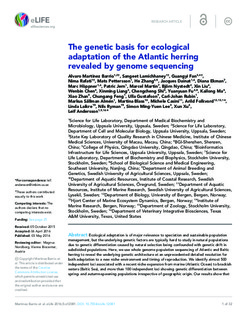| dc.contributor.author | Barrio, Alvaro Martinez | |
| dc.contributor.author | Lamichhaney, Sangeet | |
| dc.contributor.author | Fan, Guangyi | |
| dc.contributor.author | Rafati, Nima | |
| dc.contributor.author | Pettersson, Mats | |
| dc.contributor.author | Zhang, He | |
| dc.contributor.author | Dainat, Jacques | |
| dc.contributor.author | Ekman, Diana | |
| dc.contributor.author | Höppner, Marc P. | |
| dc.contributor.author | Jern, Patric | |
| dc.contributor.author | Martin, Marcel | |
| dc.contributor.author | Nystedt, Björn | |
| dc.contributor.author | Liu, Xin | |
| dc.contributor.author | Chen, Wenbin | |
| dc.contributor.author | Liang, Xinming | |
| dc.contributor.author | Shi, Chengcheng | |
| dc.contributor.author | Fu, Yuanyuan | |
| dc.contributor.author | Ma, Kailong | |
| dc.contributor.author | Zhan, Xiao | |
| dc.contributor.author | Feng, Chungang | |
| dc.contributor.author | Gustafson, Ulla | |
| dc.contributor.author | Rubin, Carl-Johan | |
| dc.contributor.author | Almén, Markus Sällman | |
| dc.contributor.author | Blass, Martina | |
| dc.contributor.author | Casini, Michele | |
| dc.contributor.author | Folkvord, Arild | |
| dc.contributor.author | Laikre, Linda | |
| dc.contributor.author | Ryman, Nils | |
| dc.contributor.author | Lee, Simon Ming-Yuen | |
| dc.contributor.author | Xu, Xun | |
| dc.contributor.author | Andersson, Leif | |
| dc.date.accessioned | 2016-08-24T12:06:35Z | |
| dc.date.accessioned | 2016-09-21T13:01:26Z | |
| dc.date.available | 2016-08-24T12:06:35Z | |
| dc.date.available | 2016-09-21T13:01:26Z | |
| dc.date.issued | 2016-05-03 | |
| dc.identifier.citation | eLife 2016;5:e12081 | nb_NO |
| dc.identifier.issn | 2050-084X | |
| dc.identifier.uri | http://hdl.handle.net/11250/2409387 | |
| dc.description | - | nb_NO |
| dc.description.abstract | Ecological adaptation is of major relevance to speciation and sustainable population management, but the underlying genetic factors are typically hard to study in natural populations due to genetic differentiation caused by natural selection being confounded with genetic drift in subdivided populations. Here, we use whole genome population sequencing of Atlantic and Baltic herring to reveal the underlying genetic architecture at an unprecedented detailed resolution for both adaptation to a new niche environment and timing of reproduction. We identify almost 500 independent loci associated with a recent niche expansion from marine (Atlantic Ocean) to brackish waters (Baltic Sea), and more than 100 independent loci showing genetic differentiation between spring- and autumn-spawning populations irrespective of geographic origin. Our results show that both coding and non-coding changes contribute to adaptation. Haplotype blocks, often spanning multiple genes and maintained by selection, are associated with genetic differentiation. | nb_NO |
| dc.language.iso | eng | nb_NO |
| dc.publisher | eLife Sciences Publications | nb_NO |
| dc.rights | Navngivelse-DelPåSammeVilkår 3.0 Norge | * |
| dc.rights.uri | http://creativecommons.org/licenses/by-sa/3.0/no/ | * |
| dc.title | The genetic basis for ecological adaptation of the Atlantic herring revealed by genome sequencing | nb_NO |
| dc.type | Journal article | nb_NO |
| dc.type | Peer reviewed | nb_NO |
| dc.date.updated | 2016-08-24T12:06:35Z | |
| dc.source.journal | eLIFE | nb_NO |
| dc.identifier.doi | 10.7554/eLife.12081 | |
| dc.identifier.cristin | 1368557 | |

